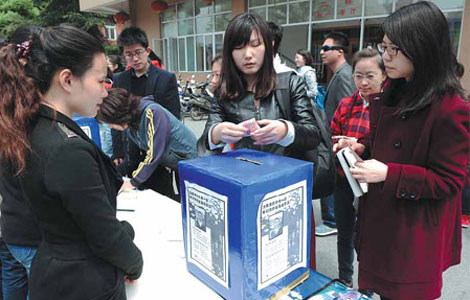Better predictions and response
Updated: 2013-05-13 07:31
By Ma Shengli (China Daily)
|
|||||||||||
Although there has been much improvement, greater efforts are needed to mitigate the effects of future earthquakes
China is among the countries most frequently hit by strong earthquakes - those over magnitude-7 on the Richter scale - and 49 percent of its territory, 50 percent of its urban areas, and 70 percent of its cities with a population of more than 1 million, are located in high intensity quake zones.
To reduce the casualties and economic losses resulting from earthquakes, the government has gradually established an earthquake monitoring, warning and emergency rescue system.
As a result, there has been a dramatic increase in the speed of reporting earthquakes. China's seismic network released a preliminary report just three minutes after the magnitude-7 earthquake hit Lushan in Southwest China's Sichuan province on April 20, and a corrected result was published within 10 minutes. Moreover, emergency assessment and response have been significantly advanced since the earthquake in 2008 that devastated Wenchuan county also in Sichuan, as evidenced by the more timely and effective rescue and relief efforts this time.
And the country's preparedness has also greatly improved since the Wenchuan earthquake. Some of the areas hit by the Lushan earthquake overlapped with the areas hit by Wenchuan earthquake, but the buildings constructed after that quake were not severely damaged this time, which means that these buildings are more resistant to earthquakes than their predecessors. Also residents' awareness of what to do in an earthquake has been raised, which helped reduce the number of casualties this time.
However, China's high-speed development, especially its accelerated urbanization process, has resulted in a significant increase in major construction projects and infrastructure, so earthquake preparedness and response are more important than ever nowadays, and they require the participation of the government and the public.
Internationally, the most common and basic solution for disaster reduction is to improve the total disaster preparedness and protection capabilities. Japan, for instance, has an extensive safety network with effective social management mechanism and public service system.
The China Earthquake Administration put forward a guiding principle in 2011, which makes "mitigating the casualty and property losses brought about by earthquakes to the maximum" as the fundamental objective. The goal is to ultimately improve the nation's capability to predict earthquakes and mitigate their effects through technological upgrading and innovation, better training for rescue workers and improved social management. Governments at all levels need to meet their responsibilities, and it is important that China boost the professionalism of its rescue efforts and promote scientific and technical innovation to improve its prediction and response capabilities.
At present emergency rescue is still the most direct measure when an earthquake occurs, but the reinforcement of seismic surveillance and increased forecast accuracy is obviously the most effective way to reduce the number of casualties.
However, this is one of world's top scientific challenges. China is promoting better short-term and long-term forecasting of earthquakes. To achieve this, the China Earthquake Administration has been upgrading its surveillance capabilities and completing the layout of a high precision seismic network. By accumulating information on earthquake precursors and setting up theoretical models of strong quakes, hopefully, more effective earthquake predictions can be achieved in the future.
The administration has also drawn up a development and policy plan for earthquake science and technology; including key national projects, and it is organizing and coordinating the research and development of technology and equipment for rescue work after an earthquake. But better training of rescue workers, with more education bases and courses in universities, is needed and scientific and technological talent is also badly needed to improve the overall quality of the nation's earthquake scientists.
Finally, it is necessary to actively raise people's awareness of what they should do during and after an earthquake. Publicity and education are needed to instill in the public how to respond should an earthquake hit.
The author is deputy director of the Institute of Geology of the China Earthquake Administration.
Today's Top News
Taiwan dispatches fleet to protect fishing boats
Deputy head of top economic planner probed
China, ASEAN to strengthen mining cooperation
Taiwan demands Filipino response
Moving overseas a remedy for nurses
Death toll rises in Sichuan coal mine explosion
Disclosure delays help fuel online rumors
Warming to Arctic exploration idea
Hot Topics
Lunar probe , China growth forecasts, Emission rules get tougher, China seen through 'colored lens', International board,
Editor's Picks

|

|

|

|

|

|





